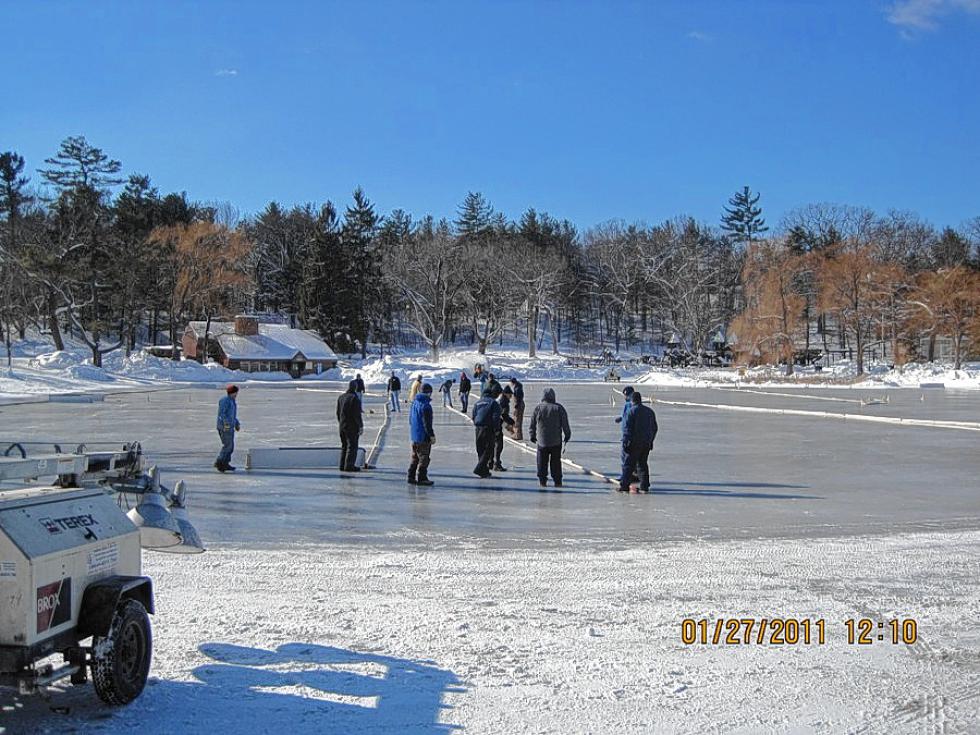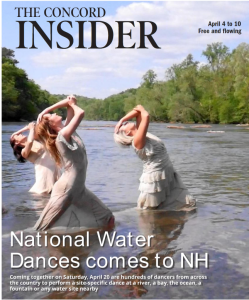The 1883 Black Ice Pond Hockey Championship has become a signature event in Concord every year.
When late January rolls around, a chill fills the air and excitement fills the hearts and minds of the city. Everybody knows that a weekend of classic outdoor hockey – and general good times – is about to get under way.
But the tournament is a big undertaking – eight rinks have to be set up on solid ice, tents need to be put up, boards and goals need to be maintained, power and heat need to be connected, things need to be organized and coordinated.
And that’s just the tip of the iceberg.
Chris Brown, the event’s organizer, knows a thing or two about setting up the fan-favorite annual tournament. After all, he’s been doing it since the first one, in 2011.
Despite the incredibly hectic schedule he keeps around this time of year (he is also president of New Hampshire Distributors), he somehow managed to find the time to tell us all about what goes into setting up the Black Ice tourney. And, of course, we’ve decided to share that with you.
What’s the first step of getting the tournament together?
It’s been a process that’s evolved over the years, but in the fall we’ll have a work day with the Black Ice volunteers that will assess what we need fixed, built, added to. We always make a hit list after the year and kind of be ready to go in fall – what can we do differently, what can we add?
How are the rinks set up?
The boards were built basically for the first tournament. We don’t necessarily have snow banks, we’re going on a pond maintained by the city – which is great. The ice is good, the surface is good to skate on. Most tournaments will use piled up snow on the sides of rinks to retain each rink. So we basically had a few members create kind of a prototype rink, which is wooden brackets, plywood. And then basically insulation, pipe insulation, on top of it to give it cushion. It’s all bolted and bracketed together. All these brackets and boards take a beating throughout the tourney, so normally some time in October we’ll open up the four pods we have in storage and kind of assess what needs to be fixed. The boards take a beating, and the nets take an absolute thrashing. They’re pressure-treated 2-by-6 boxes. It’s really a grassroots effort. A pond hockey goal is basically a wooden box that anyone can make. The boards are a necessity to keep the games separated. On average, we’ll probably make 10 new goals and fix 10 of the old goals each year.
Where is all of this equipment stored all year?
For Black Ice, everything is stored away in these four pods. Boards, brackets, goals, scoreboards for each rink, 35 to 40 shovels. All that kind of village of whatever we have gets stored away each year to these pods in the parking lot at New Hampshire Distributors. Because of the parking lot space, we’ve obviously got the space to house some of the equipment.
What goes into preparing the ice?
We’re extremely fortunate to have Parks and Rec, who maintains the ice. They open to the public with 5, 5½ inches of ice. We’re looking for 8 to 10 inches for safety reasons. Each game you’re shoveling off the shavings that you might skate up during a game, so you’re cutting down into the existing slab there. Each night during the tourney, the city will, weather permitting, spray the ice to give it a nice sheet for the next day. This week, conditions are perfect for making ice. It’ll get thicker from Mother Nature, and also they’ll spray the top of the ice a couple times a day, depending on time.
What about the tents and PA booth?
It’s all been really a very interesting community event. The merch trailer is donated by New Hampshire Motor Speedway, so they give us one of their large souvenir trailers for the DJ and PA announcer. It kind of adds a flavor to the tournament. Everything is so close in proximity, we can have a PA announcer keep everything on task and kind of involve himself in the games – announce scores, updates. That’s an enjoyable part of the event. Neighbors will comment, “You can tell when things are going because you can hear Brian Smith’s voice over the PA system at 8 in the morning.” People have enjoyed the added comedy around the event.
What about the power – where does it all come from? And what generates the heat in the warm tents?
We bring in 25 light towers with self-contained diesel engines, and we get fuel from Johnny Prescott, a sponsor, and a lot of them are donated. We have a generator that’s brought in on a trailer that gives us power for the concession and players’ tents. Lights, heat – all those elements make it a little more comfortable. The players’ tent is on the street, and because there’s tar there we have carpet we lay down in the tent. They can walk right to the ice, all covered with carpet so you don’t need skate guards. It’s a nice comfort that people can leave their stuff in a heated tent and not have to pull it all out to the ice. That’s worked out well. The generator powers the heat, and Energy North donates the propane we have for the heaters. They’ll drop off several propane tanks we hook up to the heaters. We’re kind of a week later this year, so any time after about 3 we’re probably turning them on. On Friday night we go till 8:30, so we really need the lights.
How much time does it all take to set up?
It’s all done on the Thursday before the tournament starts. It’s a public place open for public skating, so we try to keep a short window. It’ll take probably six to seven hours for us to get everything lined up, then start bolting it down to the ice, once you know you can fit the eight rinks.
What kind of variables come into play?
Every year, the ice is a little different, depending on weather – rain, snow, flooding, how high the water was before it froze. You have a general idea of how it’s supposed to fit. You can move them around a little before you pin them down. The first year we had this, we never had any protective fencing or anything, people were right up in the action, standing on the ice – we were waiting for a lawsuit. Pucks are not very forgiving. Now we have construction fencing and bicycle barriers we rented from the tent company to put behind the rinks. It lets people get right up but not in position where they’re susceptible to getting whacked with a puck. It’s such a social event that people might not always be watching the hockey at all times.
How many people are involved in the setup?
About 100 volunteers total help with everything. We have scorers, rink monitors, we have people out there maintaining the ice. If there’s a crack, we might be able to patch it, put some water and slush on there to try to freeze it up. It’s quite an army of people that we have. And then what we have done over the last few years is enlisted a lot of the kids involved with Concord High football, Brady football, Concord hockey, Bow hockey, to help with maintenance and cleanup. Some of these young backs help us roll up the carpets and put stuff away. They allow us to feel like we can probably do this another year, rather than getting a back operation. And they’re all 100 percent volunteers. We’re a nonprofit, and all the resources and dollars we raise through the tourney goes back to recreation activities, plus donations to some of these booster clubs for coming and helping out. It’s a community event and we like to see the funds stay in the community, to support recreation.
Where do you get referees?
It kind of goes back to policing it yourself. When we grew up playing shinny hockey or street hockey, we obviously didn’t have refs. We basically settled our own disputes, and that’s kind of the philosophy behind this. We do have rink monitors and scorekeepers. They’ll try to – I don’t want to call it officiate – but they’ll try to make sure if a puck goes off the rink, the right team gets the puck. Try to keep the game going. There’s some simple things that these folks will help with some of the disputes. Some are players who play for another team who choose to volunteer. There are volunteers – the guys who put up the boards Thursday are doing rink monitoring Friday and Saturday. They’re not refs per se, they’re just monitoring the game. They’ll say, “Hey guys, be good boys,” kind of the way we did when we were kids.
How are teams booked?
Existing teams from the prior year can sign up Sept 1. New teams can go on a wait list the day after the tourney ends. But we don’t start accepting new teams until Nov. 1. In November, depending on how many prior teams registered, we’ll accept a certain number of new teams. Space is an issue, though. Eight rinks is probably about the limit of what we can fit there, so the ability to add teams is limited. We have 93 teams, with more than 45 on a wait list. It’s a wonderful problem to have. Being the biggest (pond hockey tournament in New Hampshire) probably isn’t what we’re going to be, but our job is to have an enjoyable tournament and provide a great product. It’s really been a neat citywide type of celebration – people kind of come and go, enjoy the hockey and the activities.
How was White Park chosen as the venue?
Because of its central location, it was a place everyone in Concord kind of knew. It’s the place everyone learned how to skate. It’s a spot that’s got a lot of history. Bigger isn’t always better, as long as we’re putting out a good product. And we see the city has engaged with this – restaurants, hotels getting some business because of this. Ultimately, that’s what our intention was.
How has the tournament grown over the years?
I don’t think we realized what we had (in the beginning). That first year, it was such a special feeling during the opening ceremony to kind of see what potentially this could be. To see people’s reactions to see this going on. Now it’s turned into a citywide celebration, given people an opportunity to come out of hibernation. It’s quite special to see that. We had an idea that this could be pretty good, and enthusiasm around it has kind of proven that we had a unique connection, and an event people were enjoying.










